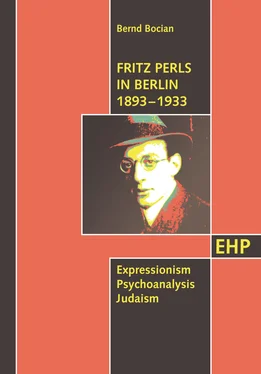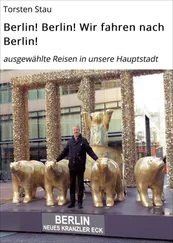Bernd Bocian - Fritz Perls in Berlin 1893 - 1933
Здесь есть возможность читать онлайн «Bernd Bocian - Fritz Perls in Berlin 1893 - 1933» — ознакомительный отрывок электронной книги совершенно бесплатно, а после прочтения отрывка купить полную версию. В некоторых случаях можно слушать аудио, скачать через торрент в формате fb2 и присутствует краткое содержание. Жанр: unrecognised, на английском языке. Описание произведения, (предисловие) а так же отзывы посетителей доступны на портале библиотеки ЛибКат.
- Название:Fritz Perls in Berlin 1893 - 1933
- Автор:
- Жанр:
- Год:неизвестен
- ISBN:нет данных
- Рейтинг книги:3 / 5. Голосов: 1
-
Избранное:Добавить в избранное
- Отзывы:
-
Ваша оценка:
- 60
- 1
- 2
- 3
- 4
- 5
Fritz Perls in Berlin 1893 - 1933: краткое содержание, описание и аннотация
Предлагаем к чтению аннотацию, описание, краткое содержание или предисловие (зависит от того, что написал сам автор книги «Fritz Perls in Berlin 1893 - 1933»). Если вы не нашли необходимую информацию о книге — напишите в комментариях, мы постараемся отыскать её.
Fritz Perls in Berlin 1893 - 1933 — читать онлайн ознакомительный отрывок
Ниже представлен текст книги, разбитый по страницам. Система сохранения места последней прочитанной страницы, позволяет с удобством читать онлайн бесплатно книгу «Fritz Perls in Berlin 1893 - 1933», без необходимости каждый раз заново искать на чём Вы остановились. Поставьте закладку, и сможете в любой момент перейти на страницу, на которой закончили чтение.
Интервал:
Закладка:
We must be careful about what we integrate into Gestalt therapy as it was intended by Fritz and Laura Perls and Paul Goodman. And if we do not wish to reverse the core of Gestalt therapy into its opposite, we must be mindful of when the limits have been reached for what can be integrated from the esoteric, transpersonal world.
I would like to thank Bernd Bocian for his valuable book and Philip Schmitz for his careful translation. My thanks as well to the German Association for Gestalt Therapy (DVG) and the European Association for Gestalt Therapy (EAGT) for supporting the translation financially. And, of course, I would also like to acknowledge publisher Andreas Kohlhage for his courage to publish in English.
Zurich, July 29, 2010
Peter Schulthess
President, European Association for Gestalt Therapy (EAGT)
Preface to the English Edition
Using Fritz Perls as an example, this book recalls the representatives of an urban avant-garde culture who were driven out of Europe, emigrated, and for the most part found a new homeland in the USA. Many an element of the lost avant-garde spirit later found its way back to Europe in an enriched form. For me, Gestalt therapy belongs in this category. This monograph is the first to focus in greater depth on the German-European roots of Gestalt therapy. It thereby bridges the continents at the same time. Hopefully, this will contribute to overcoming amnesia in both Europe and America and focus attention on an intellectual continuity which, from my perspective, has not been sufficiently recognized to date.
I have concentrated primarily on the background, that is, the experiential world in which Perls moved, and therefore also on the diverse intellectual currents that left their mark on his life, thinking, and actions. It is only this perspective that provides meaning for the ultimately scarce direct biographical data from and about the period which, after all, comprised the first 40 years of his life. Fritz Perls’s work style was not that of a theoretician whose interest lies in documenting the sources and development of the thoughts he deems important in order to render them comprehensible. My intention was to demonstrate how basic principles of Gestalt therapy emerged from the theories, artistic ideas, political crises, and social psychological atmosphere prevailing at the beginning of the 20 thcentury. If I have succeeded, in shedding light on the many kinds of influence that impinged on Perls during his years in Berlin and their importance for his later development, the effect could be twofold. We will be in a position to expand a restricted, »figure-centered« view of Perls, and, against this more comprehensive background, the richness of what later manifested as Gestalt therapy will be perceived with even greater clarity and differentiation. In his review 1of the German edition, my colleague, Detlef Klöckner, observed that reading the book made him feel »more fully ensconced in Gestalt therapy than before, and something akin to ›historically complemented‹ as well.« Conducting the research for the book had exactly the same effect on me, and I would be delighted if other colleagues were to have the same experience.
As a European and especially as a German Gestalt therapist, there was an additional matter of particular importance that I formulated trenchantly in the chapter heading »Autonomy instead of Auschwitz.« Against the backdrop of two world wars and the experience of fascism and National Socialism, Fritz Perls’s sometimes unbalanced inclination toward individuality and autonomy, and his fundamentally anti-confluent posture, cannot simply be dismissed as a personal problem. I hope deeply that the present work will make it clearer that there is a historical lesson to be learned from the survival experiences of the so-called »Expressionist generation« to which Fritz Perls belonged. The idea is to sharpen the vigilance of the individual, to strengthen people’s ability to make decisions and, if necessary, also to resist when the community, the crowd, or the greater whole either entice them or demand that they surrender themselves. Although we fully realize that Gestalt therapy was conceived as a relational approach from the very outset, and that this aspect remains one of its strengths to this day, keeping these experiences alive is part of our European legacy. In my view, this numbers among the unrelinquishable treasures of our approach.
For the realization of this translation project, I am indebted to the Executive Committee of the European Association for Gestalt Therapy (EAGT), in particular its president Peter Schulthess, and to the trustees of the German Association for Gestalt Therapy (DVG), in particular Christof Weber who provided the initial impulse. Naturally, the project would have been equally unthinkable without the interest of publisher Andreas Kohlhage (EHP) and the competence and open communication style of the translator, Philip Schmitz, to whom we are indebted for the translation of Wilhelm Reich’s »Early Writings,« and who concurrently assumed the task of editing parts of the German manuscript.
I would also like to acknowledge the following individuals for the wide range of support and concrete assistance they provided as I prepared the English edition. They are listed here in the »order of their appearance«: Zvi Lothane, New York; Nancy Amendt-Lyon, Vienna; Dan Bloom, New York; and Frank Staemmler, Würzburg.
Bernd Bocian
Genoa, May 2010
Preface and Acknowledgements (from the First German Edition)
This book is not only the first biographical study of the forty years Friedrich Salomon (»Fritz«) Perls spent in Berlin, and therewith also a book about the pre-history of Gestalt Therapy, it also simultaneously incorporates part of the history of the so-called »Expressionist generation.« The formative years in the lives of these social outsiders and pioneers of modernity began with the trauma of the First World War and extended to the era of the Weimar Republic and their emigration from Nazi Germany. Perls’s life exemplifies the suffering that was typical for this generation and brings its enormous creativity to light.
Furthermore, in describing Perls’s years in Berlin I am providing a missing piece in the mosaic of the social and intellectual history of the psychoanalytic movement. Perls came from the left wing of the Berlin Institute and as a psychoanalyst numbered among the »nonconformists, heretics, and truth seekers who were prepared to take risks« (Dahmer 1995). Until the end of his life, he remained a creative, inconvenient, and independent-minded thinker. Perls represented a species that was mourned not only by Anna Freud after its members emigrated and vanished from psychoanalytic organizations. For a deep understanding of Perls as an individual and of the historical context to be discussed here, I also consider it indispensable to know the social and psychological phenomena implied by the concept and mode of experience of a »German Jew.« German Jews made significant contributions to the Expressionist movement, both personally and in terms of content, and it was almost entirely they who carried the psychoanalytic movement. In addition to that, Perls’s central theoretical positions, such as his positive evaluation of autonomy and his critical attitude toward confluence phenomena, can only be understood against this background.
The years Perls spent in Berlin and which we will portray here reflect the fascinating and ultimately tragic history of an avant-garde, European-oriented urban culture. Beginning in 1933, the protagonists of this culture either fled from Europe and Germany, were expelled, or killed. Fritz Perls and his wife Lore managed to escape the destruction of this culture and its representatives, and they were able to integrate into their own therapeutic approach, and thereby preserve, many of the protagonists’ life and survival experiences that have lasting value for the future. As a European and in particular as a German Gestalt therapist, I felt that using Fritz Perls as an example to remember this culture, the emigrants, and the individuals was an inner obligation. It was also a matter that was close to my heart.
Читать дальшеИнтервал:
Закладка:
Похожие книги на «Fritz Perls in Berlin 1893 - 1933»
Представляем Вашему вниманию похожие книги на «Fritz Perls in Berlin 1893 - 1933» списком для выбора. Мы отобрали схожую по названию и смыслу литературу в надежде предоставить читателям больше вариантов отыскать новые, интересные, ещё непрочитанные произведения.
Обсуждение, отзывы о книге «Fritz Perls in Berlin 1893 - 1933» и просто собственные мнения читателей. Оставьте ваши комментарии, напишите, что Вы думаете о произведении, его смысле или главных героях. Укажите что конкретно понравилось, а что нет, и почему Вы так считаете.











